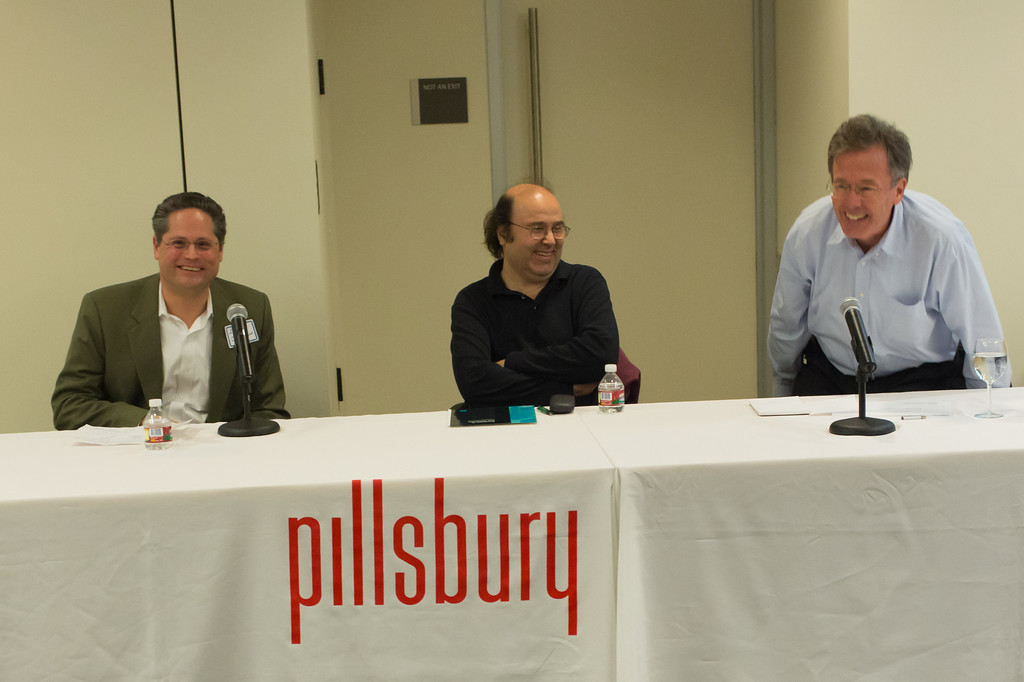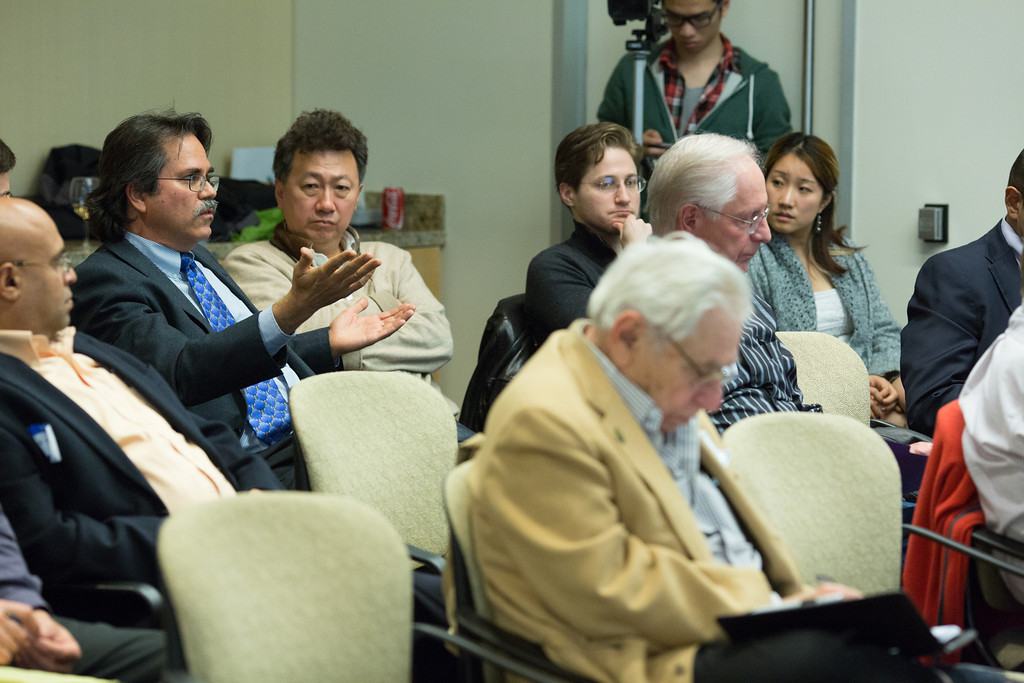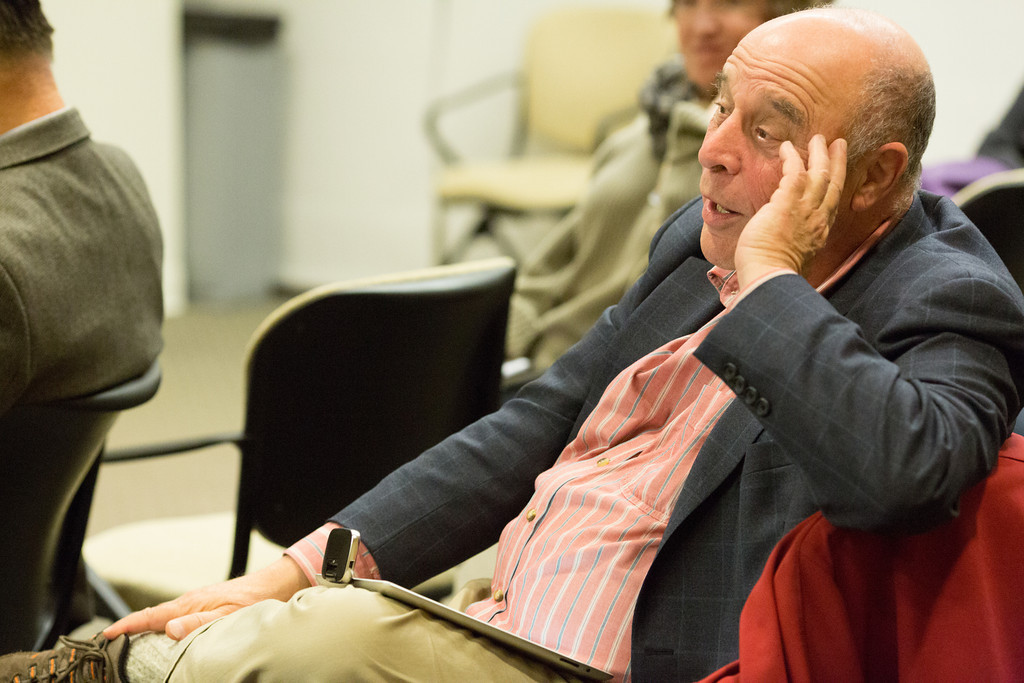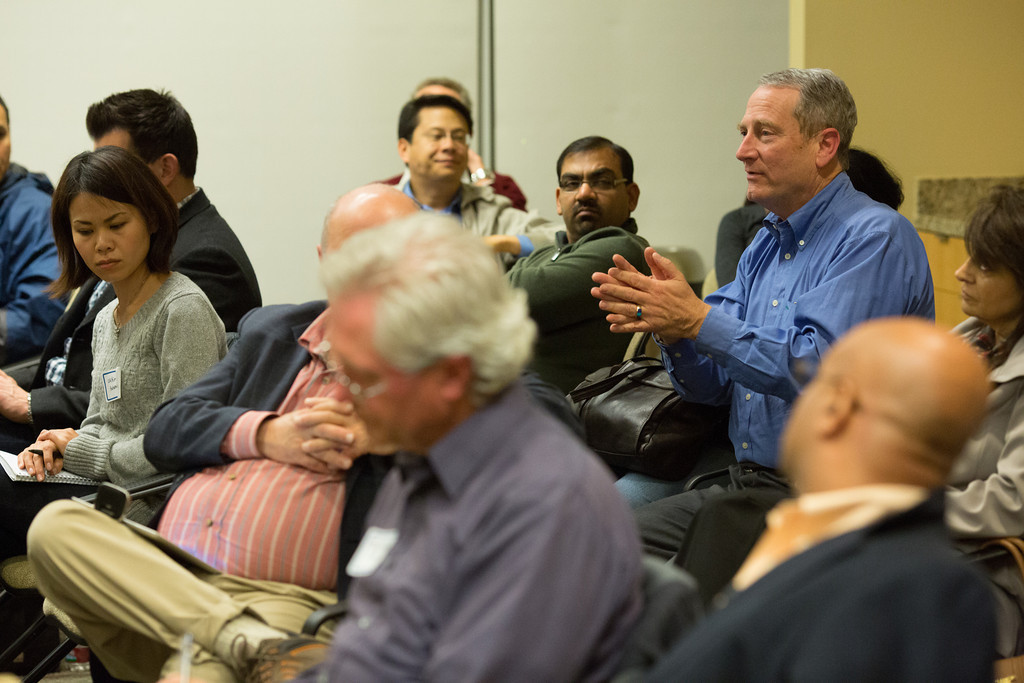Welcome to Pillsbury! Our good hosts know that it is always good to start good conversations off with a happy stomach!
Yum!
So…How DO you value intangible assets? It’s a great question that you could probably discuss for a whole day and still have more ground to cover. Last Tuesday, thirty or so business minded individuals gathered to hear three people with varied perspectives tackle this question on the campus of Pillsbury Law.
The first to speak was David Jakopin, JD, a lawyer from the Pillsbury firm. He gave an overview of what intangible assets are from the point of view of the law. In general, those are considered to be your ideas, and from the perspective of the law, the best way to protect them is to patent them–or perhaps file a patent but leave it as pending on purpose (which protects your idea by law but also leaves it a secret). Jakopin presented an outline of the timeline of many companies in the Silicon Valley. Years one and two are for idea and product development (including patent application); years three and four are when the product is introduced and (hopefully) gains momentum in the marketplace. If the patent (or patents) was applied for early enough, it should be issued sometime during years four and five. In an ideal world, the IPO happens sometime during or after year eight. If this happens, then you know that you probably handled your ideas and patents pretty well.
After Jakopin gave his presentation, our moderator for the event, SVII founder Howard Lieberman, opened the floor to the audience for questions. “Innovative people tend to deviate from linear ways of doing things,” he said.
One question that came up was whether it’s sometimes better to skip the patent process because of the high cost in time and money (paying the lawyers). Yes it can be, said, Jakopin. It depends on the timeline that you are working on and the potential to build competing products using existing technology that you didn’t patent. However, it’s still good to consult a lawyer to see whether they recommend seeking a patent or not. A good lawyer will give you an honest answer about whether or not it is worth it.
One thing for entrepreneurs to keep in mind is that patent laws in the US are changing. The rights to an idea will soon be going to whoever files a patent first, rather than whoever has the idea first. This has some theoretical pros and cons, but most of the world does it this way already, so at least consistency in that area will make some things easier. The pro argument is that this prevents people from inventing something and then hiding it and then bringing it out after someone else has developed it also. The con argument is that the legal costs of patenting things may be going up, because a premium will be placed on patents that are filed quickly.
One of the ideas that Jakopin does recommend for certain things is what is known as a “submarine patent.” This is where you file a patent, but purposefully keep it as “pending” for a long time by periodically filing continuations. The idea is that you can legally guard your idea, but also guard the privacy of it by not having the patent be public (as granted patents are).
While there is a lot to be said for patents, the system still has some controversy, and most people who work with it wish that it was much more efficient.
Our next speaker was an economist: Joel Jameson of siliconeconomics.com who focuses on innovation in the accounting space. He focused on value from a broader perspective, later bringing it to bear on the idea of intangible assets.
The value of something is highly dependent on its context. (E.g. water in the desert is more valuable than water to someone eating spicy food, which is more valuable than water to the average person in their own home.) This also applies to the context of time. Money now is more valuable than money in the future (why people will pay to borrow money). This applies generally to most assets.
A key component of intangible assets is numerical uncertainty. This is what makes them so difficult to grapple with: assessing their value will fall somewhere in the spectrum of hard to impossible, but that is also an aspect that makes them fascinating.
In considering the value of an intangible asset, says Jameson, you should make sure to consider three things: cost, market, and income potential. Income potential is generally the most difficult of those to predict, so you use the market to help (i.e. look for comparable products already on the market). Then you use the cost vs the income potential to determine if the intangible asset is worth exploiting (turning into a product).
Another angle to approach valuation is to consider these valuation drivers: Time–how long will it take to turn your intangible asset into tangible money? Scarcity–How rare or unique is the product you will be making with your intangible asset? The pain-killer vs vitamin factor–“pain killers” are more valuable, because people will pay a lot to get rid of pain, but “vitamin” type products need a lot more selling and convincing. Big companies buying other companies that they view as a threat to their business is another example of this: they buy the company to eliminate a threat (get rid of pain), but they won’t spend nearly as much to pursue an opportunity. Risk–what kind of risks are you taking on if you try to turn your asset into a product. Complementariness–I.e. does your product work well with the rest of the world; if not, it may be before its time. Build the necessary infrastructure first; that could be a product of its own.
Then we moved back into the nitty gritty with our next speaker: Neil Sherman, an engineer who founded his own company (Tag-Connect) that builds serial connectors for circuit boards.
From his perspective, the patent process was not very helpful because it cost him so much money to get patents for his project. He also brought somewhat of a new perspective on the idea of intangible assets by saying that people are the most important intangible asset. That’s an important point because it is quite difficult to quantify the value of individual people in your company, but you know that no company can function without people. This has some important off-shoots as well. Trust within a company is another huge intangible asset. The fact that it is an asset is indisputable, but trying to quantify it can be very difficult. Teamwork and other relational qualities are other intangible assets with similar qualities. These assets defy traditional accounting principles, and perhaps accounting will always ignore them because they are so difficult to quantify. But this shows a flaw in the accounting paradigm, because they affect the value of a company greatly. Perhaps a first step in grappling with this conundrum is to acknowledge that accounting will only partially illuminate the true value of a company.
Intangible assets is a broad category, and the different assets in it each have their own complexities. However, the main thing to remember about them is to not forget that they’re part of the equation and that they need to be considered when you are evaluating a company, a person, or a project.









